Actinidia kolomikta and its cultivation
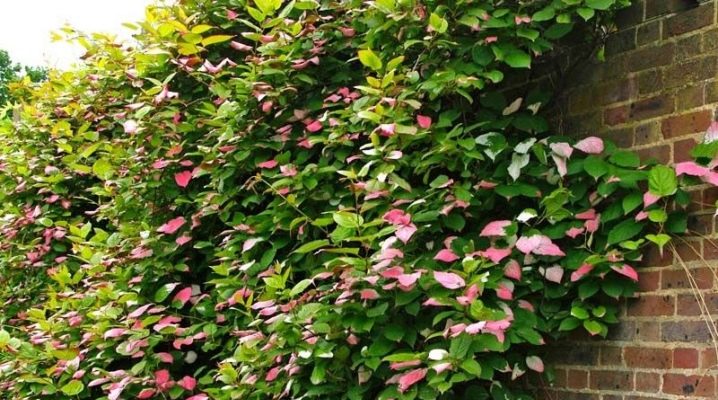
Actinidia kolomikta is a perennial vine that grows as a shrub. It belongs to the family of the same name and is often used in landscape design. Not all gardeners know the secrets of growing it.
general description
The shrub grows rapidly and is considered the largest member of the genus. The cultivation of the plant began in the 19th century. It is grown for decorative purposes and for producing fruits.
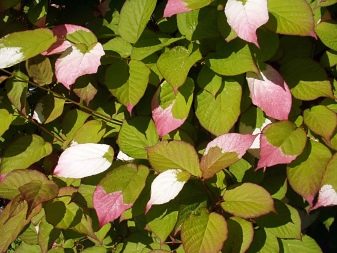

The woody liana is covered with scaly bark and has straight or curly trunks. The vine shoots are smooth, rich brown color with gloss. Young twigs cover numerous longitudinal light-colored lentils.
The foliage of actinidia kolomikt has an elliptical or ovoid shape. At the ends, the leaves are pointed, their base is rounded or heart-shaped. Plants planted in well-lit areas often have variegated foliage.
The first flowering occurs at the age of five. Flowers appear in the second half of June and adorn the plant for about three weeks. Snow-white inflorescences with a light pinkish outside are most often dioecious and unisexual. Self-fertile varieties of kolomikta with bisexual flowers are of the greatest value. They don't need pollinating plants. There are many seeds in the fruits. The plant begins to bear fruit at the age of 9 years, the fruits ripen closer to autumn... Berry picking is carried out from the end of summer until the second half of September.
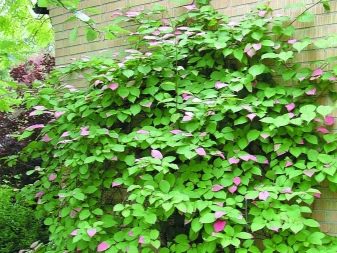
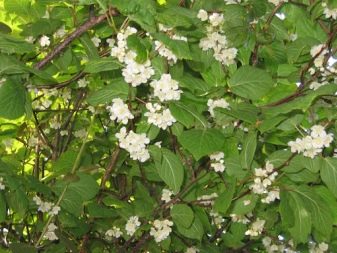
Comparison with actinidia arguta
Inexperienced gardeners often confuse actinidia colomicta and argut. There are differences between them.
Kolomikta is the most winter-hardy species, its length can be 10 meters. The fruit diameter is 20-25 mm. This variety of liana is distinguished by its maximum decorative effect.
Actinidia arguta is a strong dioecious plant that can be up to 30 meters long. The diameter of the fruit is 1.5-3 cm.
The main differences between actinidia kolomikta and argut are in size, winter hardiness, diameter of the fruit.
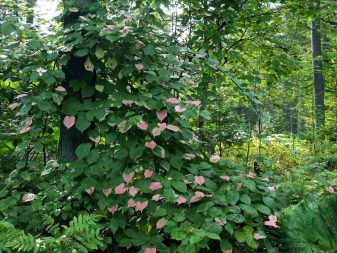

Popular varieties
Many summer residents are interested in which variety of actinidia kolomikt is better to choose for the Moscow region and the Leningrad region. Different species have different ripening times. Let's list the most popular varieties.
- Self-fertile actinidia is not afraid of freezing temperatures and begins to bear fruit in the second half of September. Its berries are very fragrant and weigh about 18 g. It is possible to harvest up to 12 kg of harvest from one bush.
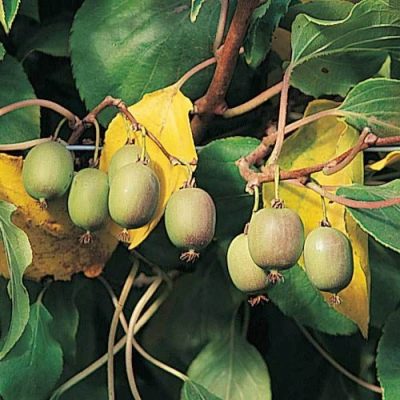
- "Sweet stick" - a domestic female variety that needs pollination. The weight of the fruits reaches 4.3 g, they have a sweet and sour taste and aroma similar to pineapple.
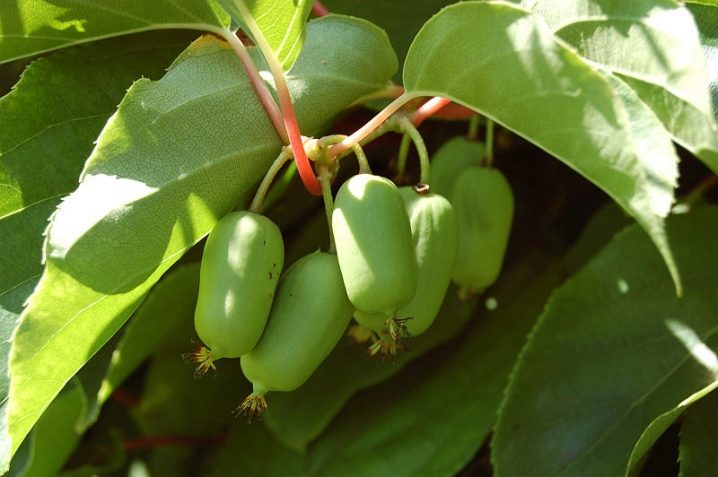
- "Clara Zetkin" - one of the most popular varieties, producing fruits 2.5-3.5 cm long. The average yield per bush is 6.5-8.5 kg. The pulp of the fruit is tender and sweet in taste.
It is a dioecious cultivar that should be planted alongside male specimens.
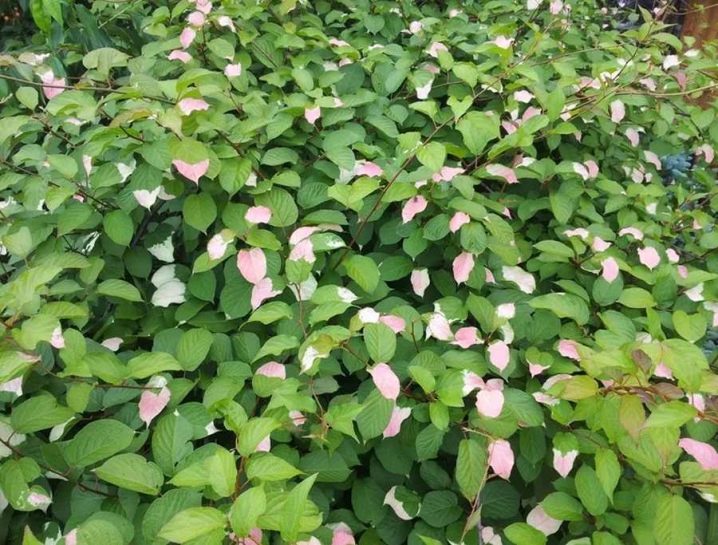
- Primorskaya - another variety that needs a male neighborhood. It is characterized by average winter hardiness, resistance to diseases and pests. The weight of the fruit reaches 8.3 g. The pulp is very delicate, the aroma contains notes of apple.
The overwhelming majority of varieties are grown in open field conditions.
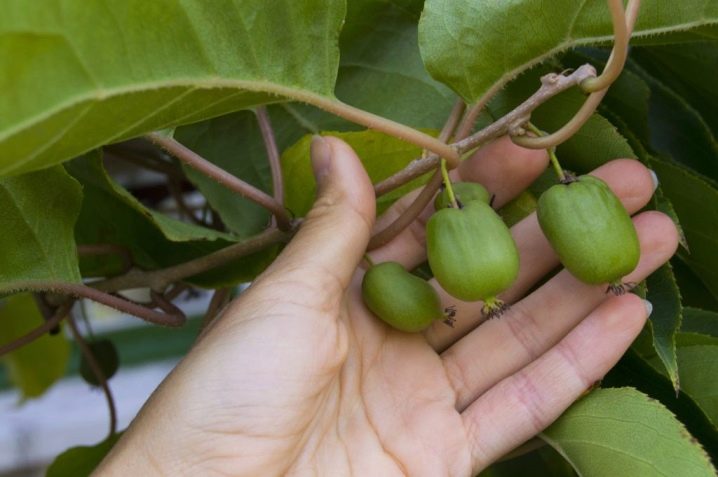
Landing
All gardeners need to know how to properly plant the actinidia kolomikta, and what kind of soil it loves. To get a good harvest, 3-4 female plants need to be planted with 1-2 male plants. It is recommended to do this in early May. Liana loves soils well saturated with moisture and enriched with humus. It cannot be planted on alkaline soils.
Seedlings are recommended to be placed in the direction from north to south... Such placement will contribute to the retention of snow in winter, provide shade to the plants from the crown in the hot season.
It is a rather shade-loving shrub, but it gives the maximum yield when it is in open sunny areas.
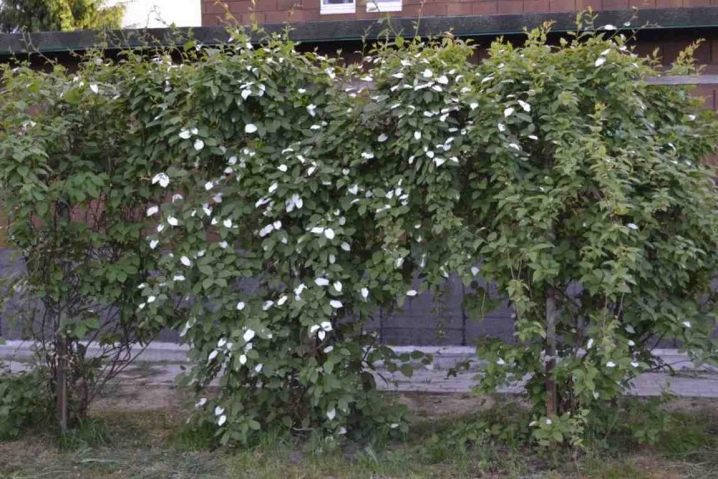
Liana is often planted along fences, it forms a hedge. It is supported by a trellis, which must be strong enough.
Recommended size of planting holes - 60x60x60 cm... They are prepared in advance, about a couple of days in advance. A drainage pillow is laid at the bottom, consisting of brick fragments, crushed stone. The thickness of the drainage is from 15 cm. The top of the pillow is covered with a soil mixture, which includes compost, sand, ash and fertilizers. All components are mixed to obtain a homogeneous substance.
After filling the hole with earth, 2-3 buckets of water are poured into it and kept for about 2 days so that the soil settles. During planting, young plants are buried so that the upper part of the root system is close to the surface. The seedlings are watered abundantly. They are placed at a distance of about 1.5-2.5 m from each other. In the early days, they need protection from the scorching sun. After landing, secure supports should be installed.
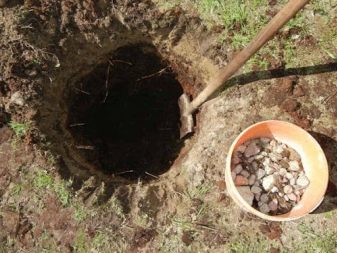
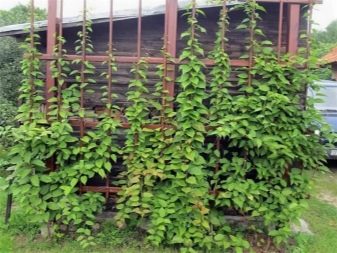
Growing care
Liana grows quite well outdoors if properly cared for. The trellis serves as a support for the climbing plant, in addition, you need to take care of proper irrigation and feeding. The care includes three main procedures: irrigation, mulching, crown correction.
Watering and feeding
Liana requires high humidity, so in dry weather you will have to pay increased attention to irrigation. It is recommended to water the plant in the evening using the sprinkling technique. You can use a sprinkler with a shower head. The main task is to thoroughly moisten the soil in the near-stem zone.
Of the top dressing of actinidia kolomikt, mulch, which is peat or humus, is most suitable. Sawdust, coniferous bark, fallen leaves will help protect the root system of the vine from the cold in winter. The recommended thickness of the mulch layer is 5-7 cm.
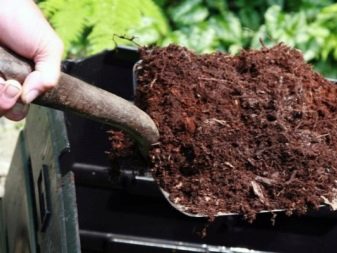
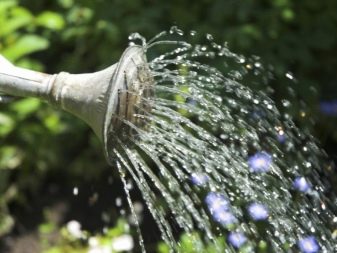
Pruning
Properly executed pruning will give the vine an aesthetic appearance and will serve as a guarantee of increasing the yield.
It is important to take into account that in the spring there is an intense sap flow in the shoots, so it is undesirable to cut the vine at this time.
It is not recommended to prune the plant at the end of summer. Even minor mechanical damage is fraught with unwanted bud awakening on young branches.
It is better to prune actinidia kolomikt during the flowering period or immediately after its end. Pruning carried out after the foliage has fallen will not harm the liana. It is necessary to remove thin and weak branches, as well as those that are frozen or dry.
Pruning can be not only sanitary but also formative. It is performed based on what kind of support is used to support the plant. Most often, a flat trellis is used, therefore, fan-shaped pruning of vines is used.

All summer residents should know how to form the crown of actinidia kolomikt, there is a certain scheme that must be followed.
- After the end of the first flowering, choose 3-4 strong, growing in the vertical direction of the shoot and fix them on the support. The remaining branches are cut at the root.
- After the leaves fall off, the sleeves should be shortened, cut them flush with the lignified part.
- Subsequent summer molding involves fixing the most powerful regrown lateral branches on the support. They need to be fixed horizontally, and the shoots remaining on the sides should be cut off.The vine is pinched in different directions.
- After the vine turns 3 years old, vertical molding is performed. The emerging twigs are attached in parallel to the "fan".
- Bush shaping is completed in the fourth year of growth. New branches are pinched horizontally, tied to the second support from the bottom.
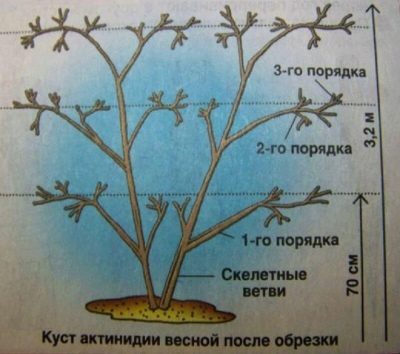
At the end of the molding, regular annual pruning is performed, as well as adjustments for sanitary purposes, root shoots are removed. Prune actinidia very carefully so as not to damage the buds present on both short and long shoots. This can lead to the loss of some of the crop next year.
At 8-10 years of age, vines are pruned for rejuvenating purposes: one of the sleeves is removed annually, replacing it with a young shoot.
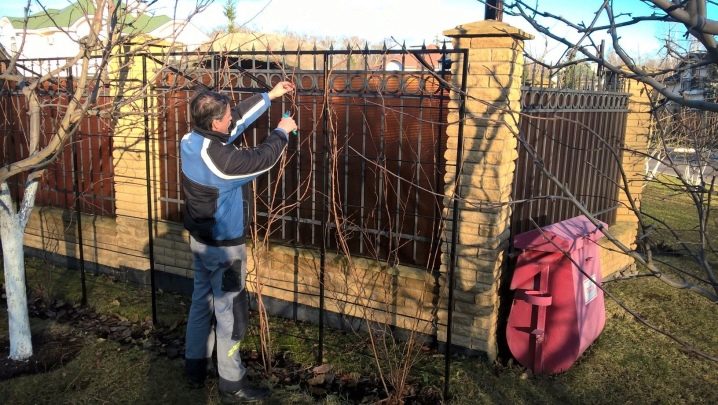
Reproduction
The easiest way to propagate actinidia is cuttings - this is usually done in the summer. Cuttings can be green and lignified. There are other methods of propagation, for example, by seeds and layering.
Let's start with the seeds. In the first week of January, they need to be placed in a nylon sock, and then in a container with wet sand. The container is covered with a plastic lid, the planting material is kept there for 2 months at a 20-degree temperature. Then the seeds are moved to the refrigerator, kept there for another 4 weeks. The container must be shaken every 10 days. It is important to ensure that the sand in which the planting material is located remains moist.
At the end of the specified period the seeds need to be washed, put on a damp cloth, place in a plastic bag, tie it up and germinate in a warm place. The sunken seeds are sown in boxes one by one. A wet substrate is preliminarily prepared, which includes compost and sand in equal proportions.
The seeds need to be buried 5 mm, adhering to the 2x2 cm scheme. The container must be kept warm, away from bright sunlight, all the time to monitor the moisture content of the substrate. It is important to protect the seedlings from the cold. In autumn, they will reach a height of 50 cm. For the period of cold weather, the container is dug into the ground and covered with dry leaves. Recommended cover thickness is 30 cm.
With the arrival of spring, the seating is performed, adhering to the 10x20 cm scheme. To do this, use a box with drainage and light nutrient soil. Seedlings need regular irrigation. In the third year, their flowering begins, it becomes possible to determine the sex. Transplantation to a permanent place is in progress. Two plants are placed in one hole.
Growing vines in a greenhouse complex takes much less time than outdoors.
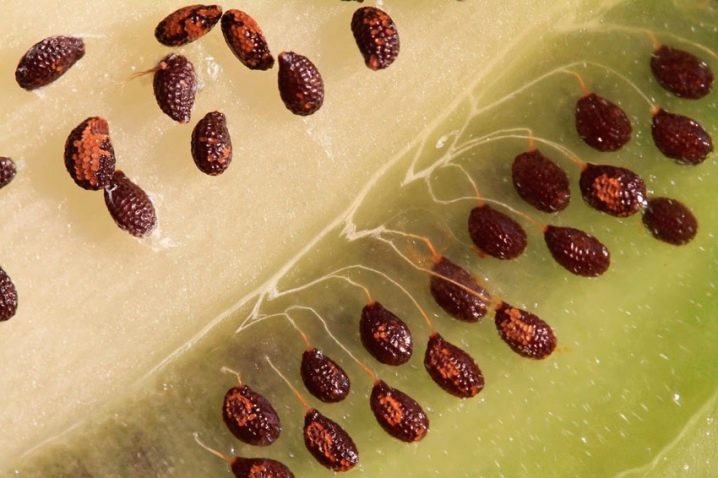
To propagate actinidia with green cuttings, you need to make a greenhouse and place its lower part in the ground. The bottom of the box is lined with a thick drainage layer and a slightly acidic substrate. River sand is laid on top, which is pre-washed, with a thickness of 3 cm.
Cutting cuttings with 2-3 buds is performed from young twigs that crunch when folded... An oblique cut is made under the kidney located at the bottom, and a straight cut under the one at the top, keeping a distance of 1 cm. The leaf from the lower kidney must be removed, and the upper one must be shortened by a third.
The lower cut must be placed in a root-forming solution for 24 hours.... Embed the finished cuttings in the sand by 2-2.5 cm. Their foliage should not be in contact. After that, the container is covered with a light-transmitting cap. It takes about a month to root. During this period, it is required to maintain the temperature regime in the region of 25 degrees. Irrigate the cuttings after the roots appear. Shoots that have dropped foliage are immediately removed from the greenhouse.

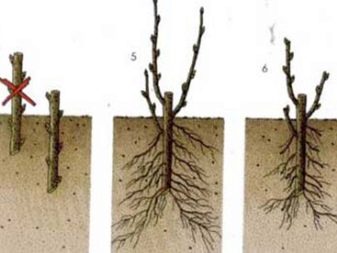
Actinidia kolomikta can be propagated not only by green, but also by lignified cuttings. This method is identical to the previous one, although there are some nuances.
Lianas begin to reproduce with lignified cuttings at the end of summer. If it's hot in August, you can postpone this procedure to September.Cuttings are taken from annual twigs that have been under the sun. Their preparation for rooting and planting in the greenhouse are carried out similarly to summer shoots.
When propagating actinidia by layering, two-year-old shoots are used.

Diseases and pests
Some gardeners ask the question of what to do if actinidia does not grow well or does not bloom. The reason may lie in diseases and pests. Vine foliage and fruits are susceptible to fungus, stains and mold can appear on them.
- Affects actinidia and powdery mildew. The pathogens of spotting can be destroyed in 2-3 treatments of the vine with Bordeaux solution. It is possible to get rid of dew by dusting actinidia with ground sulfur. After that, the plant is sprayed with soda ash twice with an interval of 10 days.
- Rot with mold is not amenable to therapy... Affected fruits are removed and destroyed, also cutting out broken and dried branches. After the foliage has fallen off, the plant and soil are sprayed with a fungicidal solution.
- As for insects, the leaf beetle poses the greatest danger to actinidia. He is able to destroy all foliage. Liana is also harmed by hawk moth caterpillars. Insecticides and acaricides are used to control pests.
- Cats ripping off the bark from it can also cause damage to the plant. This behavior of representatives of the feline family is explained by the content in the bark of a substance similar to valerian. To protect the liana, its roots are covered with wood shields, and mesh barrage structures are installed.
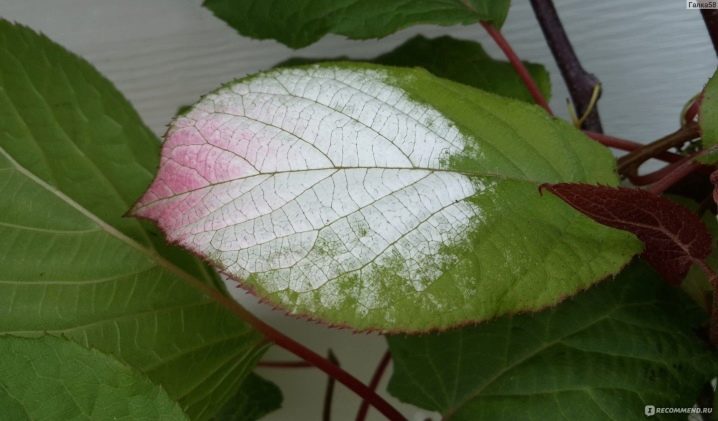
How to distinguish a female from a male?
In actinidia kolomikta, there are male and female specimens. The sex can be determined by the structure of the flowers. The male specimens have more stamens, and the pistil is absent. The females have a large pistil in the central part, which is surrounded by stamens with sterile pollen. Insects and wind carry pollen to female plants. After flowering, they form ovaries that turn into fruits.
At least two plants must be planted on the site.

Application in landscape design
Actinidia kolomikta is often planted in the garden for the purpose of decorating it. Perfect for vertical landscaping... Vine branches beautifully twine around different planes. It can be used to decorate other trees, create a hedge.
Actinidia is often decorated with verandas and gazebos, as well as fences. She is able to protect other plants from bright sun and drafts. Fences with actinidia look spectacular. The height of the plant increases by about 3 meters every year. Decorating the garden doesn't take long.
With the help of actinidia, you can disguise unattractive places in the garden, for example, household buildings, or, conversely, emphasize the beauty of a flower garden.
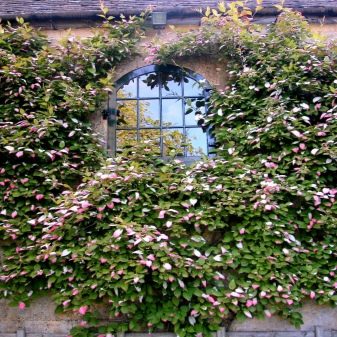
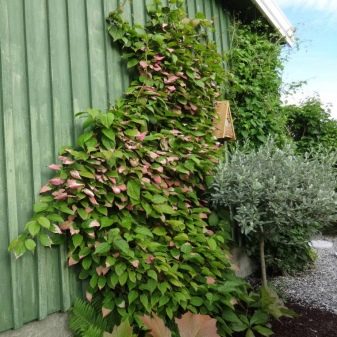
The correct approach to growing actinidia kolomikta will ensure its rapid growth.











The comment was sent successfully.